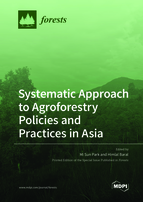Systematic Approach to Agroforestry Policies and Practices in Asia
A special issue of Forests (ISSN 1999-4907). This special issue belongs to the section "Forest Economics, Policy, and Social Science".
Deadline for manuscript submissions: closed (31 October 2021) | Viewed by 57282
Special Issue Editors
Interests: forest governance; international cooperation; global regime; community-based forest management
Interests: forest landscape restoration; landscape sustainability, biodiversity, ecosystem services; forest biomass; bioenergy and carbon sequestration
Special Issues, Collections and Topics in MDPI journals
Special Issue Information
Dear Colleagues,
Agroforestry is an intensive land management system involving the integration of tree management into crop and animal farming. It provides diverse ecosystem services by bridging agriculture, forestry, and husbandry to offer environmental, economic, and social benefits. In order to improve the benefits of agroforestry to meet development and climate goals, a systematic approach is necessary for understanding agroforestry practices, designing agroforestry policies and associated outcomes. Multiple methodologies, including systematic review and landscape restoration approaches, can be applied to analyzing agroforestry policies and ecosystem services derived from agroforestry practices. Therefore, this Special Issue focuses on systematic approaches to agroforestry policies, strategies, and practices. It includes case studies from several countries from Asia to explore economic, social, and environmental dimensions.
Dr. Himlal Baral
Dr. Mi Sun Park
Guest Editors
Manuscript Submission Information
Manuscripts should be submitted online at www.mdpi.com by registering and logging in to this website. Once you are registered, click here to go to the submission form. Manuscripts can be submitted until the deadline. All submissions that pass pre-check are peer-reviewed. Accepted papers will be published continuously in the journal (as soon as accepted) and will be listed together on the special issue website. Research articles, review articles as well as short communications are invited. For planned papers, a title and short abstract (about 100 words) can be sent to the Editorial Office for announcement on this website.
Submitted manuscripts should not have been published previously, nor be under consideration for publication elsewhere (except conference proceedings papers). All manuscripts are thoroughly refereed through a single-blind peer-review process. A guide for authors and other relevant information for submission of manuscripts is available on the Instructions for Authors page. Forests is an international peer-reviewed open access monthly journal published by MDPI.
Please visit the Instructions for Authors page before submitting a manuscript. The Article Processing Charge (APC) for publication in this open access journal is 2600 CHF (Swiss Francs). Submitted papers should be well formatted and use good English. Authors may use MDPI's English editing service prior to publication or during author revisions.
Keywords
- agroforestry (agrosilvopasture, silvopasture, forest farming, etc.)
- agroforestry and ecosystem services
- landscape restoration
- sustainability
- food security







